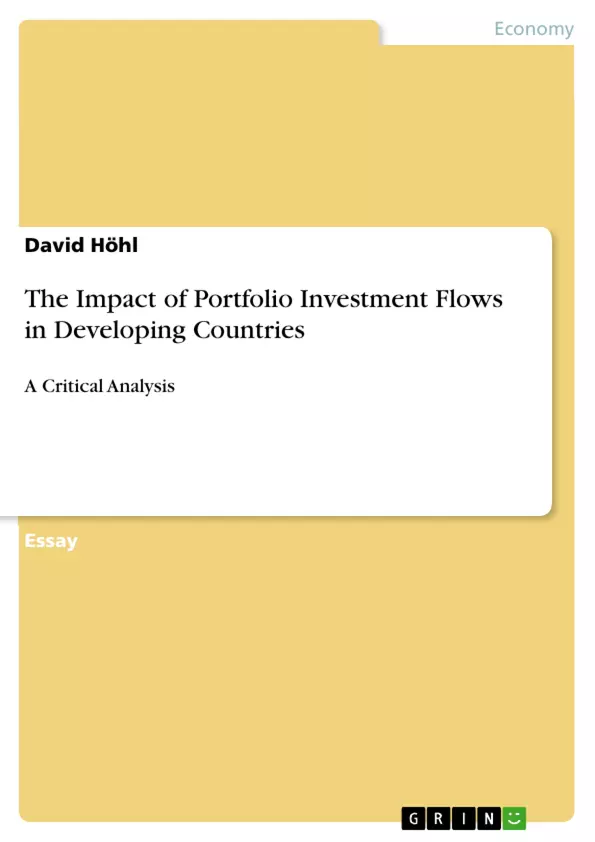This essay focuses on the impact of portfolio investment (PI)flows in developing countries (DC). My thesis statement is that PI have positive rather than negative effects on a DC’s economy since they seem to reduce the cost of capital, increase investment, and accelerate growth. Thus, capital controls should not be enforced on PI.
To address the problem of poverty in developing countries (DCs) economic governance and capital flows play a key role. The policy advice of the IMF for DCs was to liberalise the capital account, especially in the 1990s. Economists like John Williamson criticised the capital account liberalisation clearly and held it accountable for the Asian crisis that overtook the so-called “tiger economies” in 1997. He favoured foreign direct investments (FDI) compared to PI since they are much more stable. But how volatile are PI and what are their effects on the economies of DCs? Which legal framework should politicians in DCs set to manage the effects of PI? This essay will face these questions.
First of all, I will give an overview of portfolio investment flows in DCs. Afterwards, I will introduce the third-generation crisis models. Then, I will analyse the consequences of PI in DCs. Next, the consequences of PI will be evaluated, also with regard to third-generation crisis models. Given this evaluation, I will state my advice for policy makers.
Inhaltsverzeichnis (Table of Contents)
- Introduction
- Overview of Portfolio Investment Flows in Developing countries
- Third-Generation Crisis Models
- Analysis of the Consequences of Portfolio Investment Flows in Developing Countries
- Evaluation of the Consequences of Portfolio Investment Flows in Developing Countries
- Policy Advice
- Conclusion
Zielsetzung und Themenschwerpunkte (Objectives and Key Themes)
This essay aims to analyze the impact of portfolio investment flows in developing countries, with a particular focus on their consequences for economic growth and development. The essay challenges the traditional view that such investments are inherently volatile and destabilizing, arguing instead that they can have positive effects. The goal is to present a nuanced understanding of the complex relationship between portfolio investment flows and developing country economies, ultimately providing policy recommendations for managing these flows effectively.
- The role of capital flows in economic development
- The impact of portfolio investments on developing countries
- The relationship between portfolio investments and economic growth
- The role of policy in managing portfolio investment flows
- The potential benefits and risks of portfolio investment flows
Zusammenfassung der Kapitel (Chapter Summaries)
- The introduction sets the stage for the essay by discussing the significance of economic governance and capital flows in tackling poverty in developing countries. It highlights the contrasting perspectives on capital account liberalization, with a particular focus on the role of portfolio investments. The chapter introduces the essay's thesis statement: that portfolio investments can positively impact developing countries.
- Chapter two provides an overview of portfolio investment flows in developing countries, examining their trends and patterns across various regions. The chapter will likely provide insights into the sources, destinations, and dynamics of these flows.
- Chapter three delves into the theoretical framework of third-generation crisis models, which are likely to be relevant to understanding the potential risks and consequences of portfolio investments. The chapter will probably explore the various factors that can lead to financial crises in developing countries and the role that portfolio investments might play in these crises.
- Chapter four will analyze the consequences of portfolio investment flows in developing countries, examining their impact on key economic indicators such as economic growth, investment, and the cost of capital. The chapter will likely present evidence and arguments to support the thesis statement.
- Chapter five will evaluate the consequences of portfolio investment flows in light of the third-generation crisis models, potentially exploring the effectiveness of different policy responses to manage these flows. The chapter may also present case studies or empirical evidence to support its arguments.
- Chapter six will provide policy recommendations for developing countries based on the analysis presented in previous chapters. The chapter will likely focus on the need for a balanced approach to managing portfolio investment flows, considering both their potential benefits and risks.
Schlüsselwörter (Keywords)
This essay focuses on the impact of portfolio investment flows in developing countries, examining their consequences for economic growth and development. Key themes include the relationship between capital flows and economic development, the effects of portfolio investments on developing countries, and the role of policy in managing these investments. The essay explores the potential benefits and risks of portfolio investment flows, examining their impact on key economic indicators such as economic growth, investment, and the cost of capital. The essay draws upon theoretical frameworks such as third-generation crisis models to analyze the complex relationship between portfolio investments and developing country economies. Ultimately, the essay aims to provide a nuanced understanding of this relationship and offer policy recommendations for managing these flows effectively.
- Quote paper
- David Höhl (Author), 2018, The Impact of Portfolio Investment Flows in Developing Countries, Munich, GRIN Verlag, https://www.grin.com/document/465438



